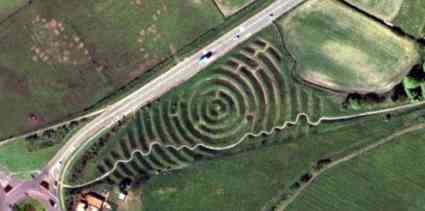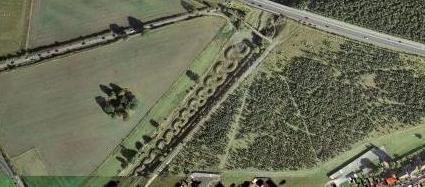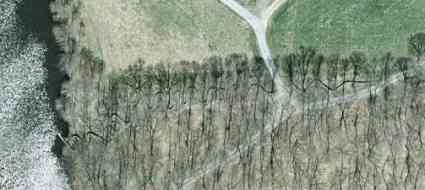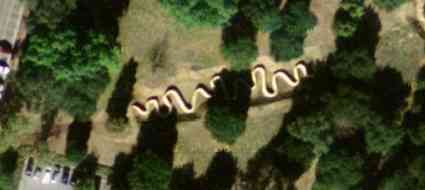Andy Goldsworthy via Google Earth
Below are Google Earth images of several of environmental artist Andy Goldsworthy’s more monumental sculptures. He works with natural materials and attempts to seamlessly integrate his pieces with the context in which they are placed. Often his works are small and temporary - collections of leaves, rocks or ice shards - the most ephemeral lasting mere minutes before being reabsorbed into their surroundings. These larger pieces are more immense and permanent, but their elegance and flow shows how well Goldsworthy’s approach scales even to these colossal proportions.
Some of these were a bit difficult to track down. I knew the general area where they were located, but had to search for them in the aerial photography. The pieces in England where not covered by high-resolution imagery, so for those I created custom layers using images taken from Windows Live Maps, which often has better coverage, although with a weaker user interface.
Click on the images to see them in context:
Other photographs and perspectives here.
This is part of a series of sculptures along a bike path. Information on the myth of the Lambton Worm here.
The 2,278-foot-long wall meanders through the woods before spanning a pond.
This 400-foot-long wall was built with the stone from buildings damaged in the 1906 and 1989 earthquakes.

Cream: The BBC Sessions
Some fit of nostalgia possessed me to pick up the album “Cream: The BBC Sessions.” These live, in-studio performances are all pretty tightly crafted, yet raucous, sticking generally to the length of their studio work—unlike the 10+ minute excursions they sometimes fell into. Its great to hear any new material of this quality after all these decades.

The liner notes point out that because of copyright restrictions the BBC wasn’t allowed to play album tracks and so got around this by having groups perform the songs for later broadcast. The album collects several such sets from 1966 through 1968, covering mostly material from “Fresh Cream” and “Disraeli Gears”, so you can sense their move from power blues into psychedelia.
There’s a really early take of “Crossroads” from 1966, before “Fresh Cream” had even been released. It’s a great rough version, not yet the tour de force Clapton famously put on display on the live portion of “Wheels of Fire”. He really opens up on a few tracks such as “Outside Women Blues” and “SWLABR”. The notes also mention a missing version of “Spoonful” from these sessions which is a real shame; I’ve always thought the solo work Clapton did on the studio version was way ahead of its time. I found this nice analysis:
Fresh Cream’s ‘Spoonful’ revealed his mastery of and ease with the quick release, which is heard at the climax point of the ‘Spoonful solo’. Here he creates anticipatory tension with the hanging second string stretch vibrato (E note) on the 15th fret and then rips into a fast minor modal riff that leads the listener back into a series of lashing bends and sharply picked notes, using hammer-ons and other finger tonalities, while slowly descending and tapering off to the close. This type of solo is masterful in its construction, execution, emotional intensity and attack.
This bit of video captures Clapton, Bruce and Baker at their peak, performing a blistering version of “Crossroads”:
Cream at the Royal Albert Hall, November 26th, 1968.
It always amazes me when I stop and realize that Clapton was barely 20 years old when these earliest recordings where made, and was not yet 23 when he set down his definitive solo at the Winterland Ballroom in March of 1968.

A Transmissible Parasitic Cancer Discovered
In a recent article in the journal Cell, scientists from University College London and the University of Chicago have demonstrate conclusively that the cancer cells themselves are the contagious agent of canine transmissible venereal tumor (CTVT), commonly known as Sticker’s sarcoma.
While other cancers have been shown to be contagious through viruses, in this case, the tumor itself is spreading between individual canines—it is as if the cancer is metastasizing parasitically between individuals.
The genomes of the cancer cells are different from those of their hosts and are more closely related than those of even the most in-bred dog breeds, implying that the mutation emerged relatively recently.
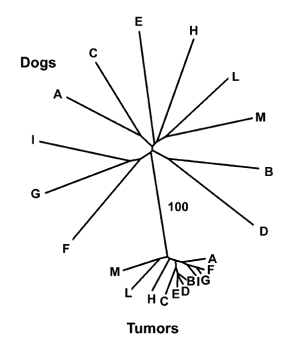
Chord distance graph, showing the relative genetic distance between individual canines and their respective tumor cells.
Using genetic analysis, the authors show that the cancerous cells from any individual tumor are clones of a single malignant cell that mutated between 250 and 2500 years ago.
While this estimated date indicates a relatively recent evolutionary origin, CTVT represents the oldest known mammalian somatic cell in continuous propagation, having undergone countless mitoses and host-to-host transfers.
The mutated cell attained the ability to metastasize into a new host without initially being attacked by the host’s immune system and survive long enough to infect again.


